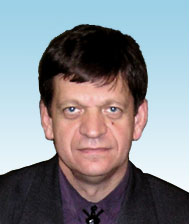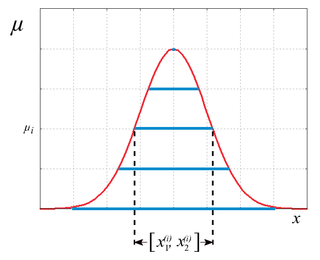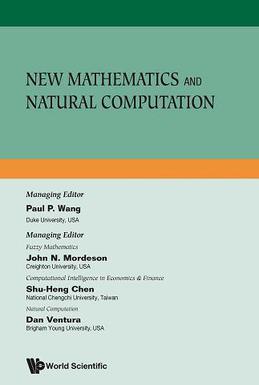Fuzzy logic is a form of many-valued logic in which the truth value of variables may be any real number between 0 and 1. It is employed to handle the concept of partial truth, where the truth value may range between completely true and completely false. By contrast, in Boolean logic, the truth values of variables may only be the integer values 0 or 1.
In mathematics, fuzzy sets are sets whose elements have degrees of membership. Fuzzy sets were introduced independently by Lotfi A. Zadeh in 1965 as an extension of the classical notion of set. At the same time, Salii (1965) defined a more general kind of structure called an L-relation, which he studied in an abstract algebraic context. Fuzzy relations, which are now used throughout fuzzy mathematics and have applications in areas such as linguistics, decision-making, and clustering, are special cases of L-relations when L is the unit interval [0, 1].
Computational archaeology describes computer-based analytical methods for the study of long-term human behaviour and behavioural evolution. As with other sub-disciplines that have prefixed 'computational' to their name, the term is reserved for methods that could not realistically be performed without the aid of a computer.

Lotfi Aliasker Zadeh was a mathematician, computer scientist, electrical engineer, artificial intelligence researcher, and professor of computer science at the University of California, Berkeley. Zadeh is best known for proposing fuzzy mathematics, consisting of several fuzzy-related concepts: fuzzy sets, fuzzy logic, fuzzy algorithms, fuzzy semantics, fuzzy languages, fuzzy control, fuzzy systems, fuzzy probabilities, fuzzy events, and fuzzy information. Zadeh was a founding member of the Eurasian Academy.
The expression computational intelligence (CI) usually refers to the ability of a computer to learn a specific task from data or experimental observation. Even though it is commonly considered a synonym of soft computing, there is still no commonly accepted definition of computational intelligence.
In computer science and operations research, Genetic fuzzy systems are fuzzy systems constructed by using genetic algorithms or genetic programming, which mimic the process of natural evolution, to identify its structure and parameter.
Society for Industrial and Applied Mathematics (SIAM) is a professional society dedicated to applied mathematics, computational science, and data science through research, publications, and community. SIAM is the world's largest scientific society devoted to applied mathematics, and roughly two-thirds of its membership resides within the United States. Founded in 1951, the organization began holding annual national meetings in 1954, and now hosts conferences, publishes books and scholarly journals, and engages in advocacy in issues of interest to its membership. Members include engineers, scientists, and mathematicians, both those employed in academia and those working in industry. The society supports educational institutions promoting applied mathematics.
Fuzzy mathematics is the branch of mathematics including fuzzy set theory and fuzzy logic that deals with partial inclusion of elements in a set on a spectrum, as opposed to simple binary "yes" or "no" inclusion. It started in 1965 after the publication of Lotfi Asker Zadeh's seminal work Fuzzy sets. Linguistics is an example of a field that utilizes fuzzy set theory.

Miodrag S. Petković is a mathematician and computer scientist. In 1991 he became a full professor of mathematics at the Faculty of Electronic Engineering, University of Niš in Serbia.
Type-2 fuzzy sets and systems generalize standard Type-1 fuzzy sets and systems so that more uncertainty can be handled. From the beginning of fuzzy sets, criticism was made about the fact that the membership function of a type-1 fuzzy set has no uncertainty associated with it, something that seems to contradict the word fuzzy, since that word has the connotation of much uncertainty. So, what does one do when there is uncertainty about the value of the membership function? The answer to this question was provided in 1975 by the inventor of fuzzy sets, Lotfi A. Zadeh, when he proposed more sophisticated kinds of fuzzy sets, the first of which he called a "type-2 fuzzy set". A type-2 fuzzy set lets us incorporate uncertainty about the membership function into fuzzy set theory, and is a way to address the above criticism of type-1 fuzzy sets head-on. And, if there is no uncertainty, then a type-2 fuzzy set reduces to a type-1 fuzzy set, which is analogous to probability reducing to determinism when unpredictability vanishes.

A fuzzy number is a generalization of a regular real number in the sense that it does not refer to one single value but rather to a connected set of possible values, where each possible value has its own weight between 0 and 1. This weight is called the membership function. A fuzzy number is thus a special case of a convex, normalized fuzzy set of the real line. Just like fuzzy logic is an extension of Boolean logic, fuzzy numbers are an extension of real numbers. Calculations with fuzzy numbers allow the incorporation of uncertainty on parameters, properties, geometry, initial conditions, etc. The arithmetic calculations on fuzzy numbers are implemented using fuzzy arithmetic operations, which can be done by two different approaches: (1) interval arithmetic approach; and (2) the extension principle approach.

The Institute of Mathematics and Applications (IMA), located in Bhubaneswar, Odisha, in India, is a research and education institution that was established by the Government of Odisha in 1999. Its dual purposes are to conduct advanced research in pure and applied mathematics and to provide postgraduate education leading to master's and Ph.D. degrees in mathematics, computation, computational finance, and data science. The institute also runs training programs in schools aimed at increasing mathematics awareness and leading to competitions such as the Mathematics Olympiads. The UG and PG courses are currently affiliated to Utkal University, which is the largest affiliating university in the country.

New Mathematics and Natural Computation is an interdisciplinary journal founded in 2005 and is now published by World Scientific. It covers mathematical uncertainty and its applications to computational, biological and social sciences, with a specific focus on relatively unexplored areas in mathematical uncertainty, such as fuzzy sets and fuzzy logic.

Open Systems & Information Dynamics (OSID) is a journal published by World Scientific. It covers interdisciplinary research in mathematics, physics, engineering and life sciences based upon the fields of information processing, storage and transmission, in both quantum and classical settings, with a theoretical focus. Topics include quantum information theory, open systems, decoherence, complexity theory of classical and quantum systems and other models of information processing.
Pedometric mapping, or statistical soil mapping, is data-driven generation of soil property and class maps that is based on use of statistical methods. Its main objectives are to predict values of some soil variable at unobserved locations, and to access the uncertainty of that estimate using statistical inference i.e. statistically optimal approaches. From the application point of view, its main objective is to accurately predict response of a soil-plant ecosystem to various soil management strategies—that is, to generate maps of soil properties and soil classes that can be used for other environmental models and decision-making. It is largely based on applying geostatistics in soil science, and other statistical methods used in pedometrics.
The Iranian Journal of Fuzzy Systems is a peer-reviewed scientific journal published by the University of Sistan and Baluchestan. It covers research on theory and applications of fuzzy sets and systems in the areas of foundations, pure mathematics, artificial intelligence, uncertainty modeling, and other related aspects.

Romano Scozzafava is an Italian mathematician known for his contributions to subjective probability along the lines of Bruno de Finetti, based on the concept of coherence. He taught Probability Calculus at the Engineering Faculty of the Sapienza University of Rome from 1979 to his retirement.
The International Journal of Computer Mathematics is a monthly peer-reviewed scientific journal covering numerical analysis and scientific computing. It was established in 1964 and is published by Taylor & Francis. The editors-in-chief are Choi-Hong Lai, Abdul Khaliq, and Qin (Tim) Sheng. The collaborative sister journal International Journal of Computer Mathematics: Computer Systems Theory, covering the theory of computing and computer systems was established in 2016.
Bernadette Bouchon-Meunier is a retired French computer scientist specializing in fuzzy logic. She is a director of research, emeritus, for the French National Centre for Scientific Research (CNRS), the former head of the Department of Databases and Machine Learning (DAPA) in LIP6, a computer science laboratory operated jointly by CNRS and Pierre and Marie Curie University, editor-in-chief of the International Journal of Uncertainty, Fuzziness and Knowledge-Based Systems, and a past president of the IEEE Computational Intelligence Society.






